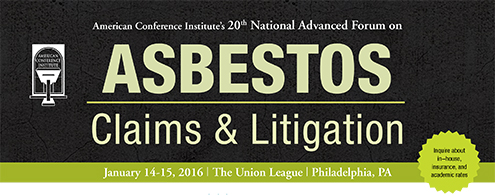Category: Insurance & Reinsurance, Legal Conferences
Asbestos Claims & Litigation: Q&A with Co-Chair Carl G. Snider
-
Carol G. Snider, Partner, Barclay Damon, LLP will be co-chairing ACI’s 20th National Forum on Asbestos Claims & Litigation, January 14-15, 2016 at The Union League in Philadelphia, PA. In anticipation of the conference, check out our recent Q&A with Carol. All statements and views expressed by Carol are her own and do not necessarily reflect those of Barclay Damon, LLP or her clients.
1. In asbestos litigation, how are the costs of going to trial weighed against settlement?
The factors that go into taking a matter to trial vs. resolving in an asbestos case are comparable to any litigated matter. The litigant exams the cost, which includes out of pocket expenses, the impact a verdict will have on a client’s reputation in the community or marketplace, the exposure of an adverse verdict compared to the amount for which a case can be resolved. Further, the client must decide whether the case is one that they really are comfortable taking to trial (even if you win the trial, are there negatives for simply trying the case). In addition, because asbestos cases have the factor of involving many of the same plaintiff’s counsel, as well as some of the same legal issues, a defendant must factor in the impact of taking a particular case to trial on future matters they may have with that or other plaintiff’s counsel.
2. Will Garlock lead to new approaches to asbestos bankruptcy?
Hopefully the Garlock decision will serve to educate the courts of the impact of the bankruptcy trust filings to the sums that will actually be recovered by plaintiffs in each case. That understanding should lead to a more open discovery process, permitting defendants to obtain information about trust filings, a more transparent system with each of the individual trusts, a mandate that plaintiff’s counsel file all trust applications during the pendency of the law suit as well as and having the monies collected, whether or not received, act as set-off to any eventual verdict.
3. What claims are you seeing more of: Lung cancer or Mesothelioma?
This varies by the individual plaintiffs’ firms. Clearly we are seeing an increase in lung cancer filings. However, the majority of the cases filed in my jurisdictions are still individuals that are alleging mesothelioma as a result of asbestos exposure.
4. In asbestos litigation, how do you explain to younger jurors what the state of the art was 50 years ago?
The process of changing a juror’s perspective for a State of the Art defense begins at voir dire. The defense attorney needs to find something to which the typical juror can relate preferably from personal experience. I often use the seat belt explanation, relating how, as growing up, my parents never required us to wear a seat belt, even though they were in every car from the early 1960’s. Today, a person seeing children in a car without a seatbelt might result in a call to the police or children’s services. But one cannot judge the parents of the 1960’s (or my parents) from today’s standards. This aptly explains, in terms that most jurors understand, how things were different 50 years ago and that one cannot use hindsight or today’s knowledge to judge long-ago behavior. Regardless of the analogy, it must be one that the juror can understand and the attorney can personalize. After that, SOTA is in the hands of the experts. The defense attorney just needs to be assured that they select jurors that understand the concept and are open to applying it at trial.
When: Thursday, January 14 to Friday, January 15, 2016
Where: The Union League – Philadelphia, PA
Learn More: http://goo.gl/FPPx4v
Keep the discussion going and join us on Linkedin:
ACI Reinsurance/Insurance: Legal, Regulatory, and Compliance Experts Group
Follow Us on Twitter:
@Insurance_ACI To join the conversation use #ACIAsebestos
